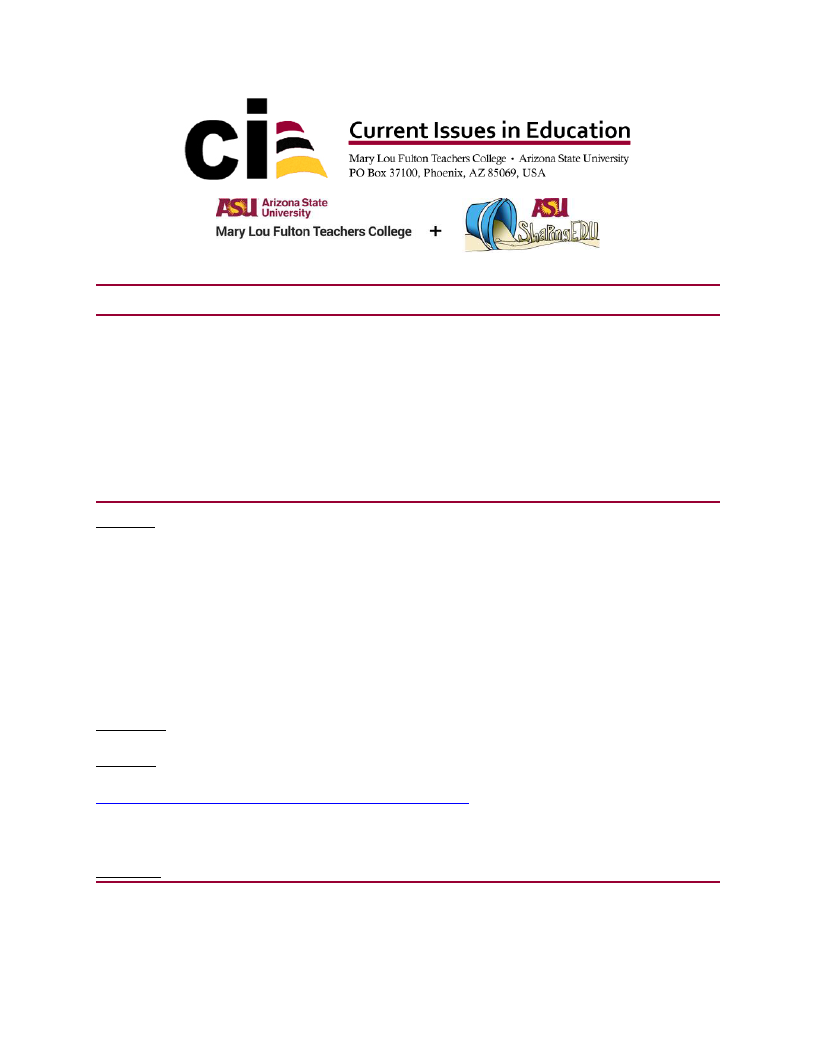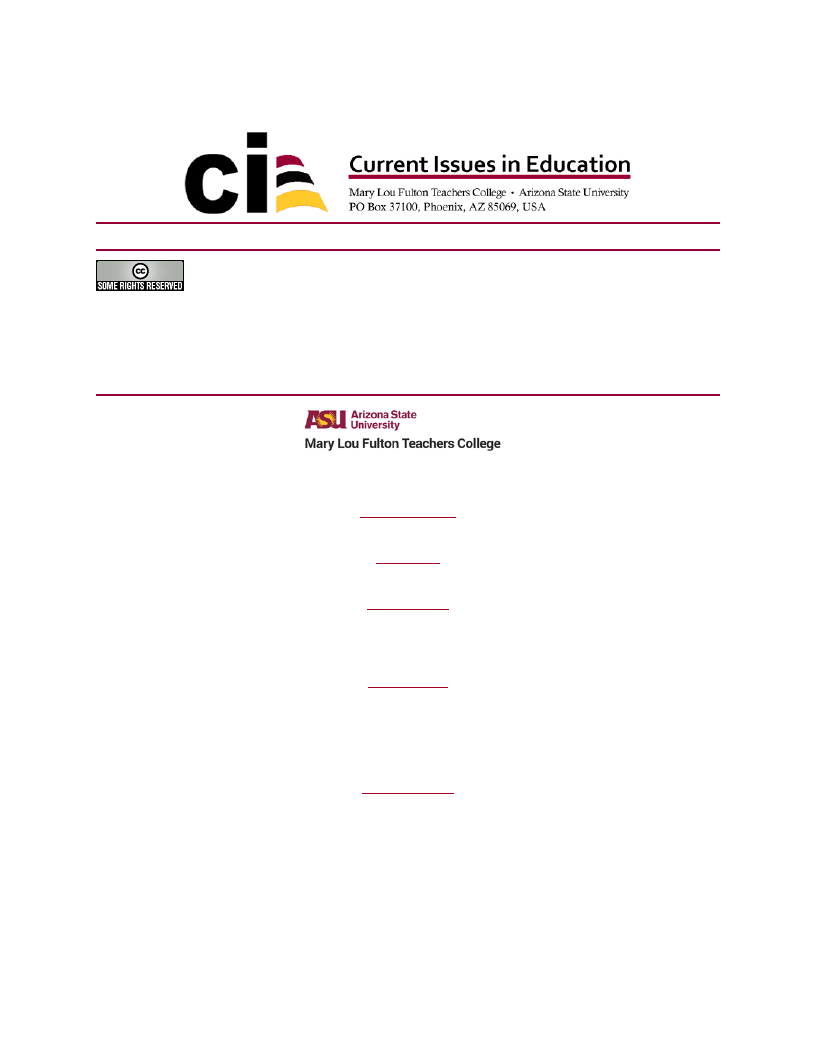
Volume 22, Issue 1
January 7, 2021
ISSN 1099-839X
Shaping the Futures of Learning in the Digital Age
Designing Learning Experiences for the Future of Learning in the
Digital Age: A Proposed Framework
Derek Thurber
Arizona State University
Abstract: While our understanding of how we learn has grown exponentially, our knowledge of
how to incorporate these ideas when designing instruction has not. This paper proposes a new
framework for designing learning experiences which build on existing instructional design models
but also incorporates a deep understanding of humans, how we learn, what motivates us, what
causes us to lose interest, and what instruction will get us to remember and use our knowledge.
The learning experience design framework includes three parts which form a continuous cycle of
development and improvement: planning, creating, and refining, all informed by key situational
factors. While non-linear, each part is further divided into two sections to address both sides of
designing a learning experience: the learning and the experience. These sections can guide anyone
into designing better learning experiences for the future of learning in the digital age.
Keywords: Learning Experience, Design Thinking, Learning Science, Instructional Design, LX
Citation: Thurber, D. (2021). Designing learning experiences for the future of learning in the
digital age: A proposed framework. Current Issues in Education, 22(1). Retrieved from
http://cie.asu.edu/ojs/index.php/cieatasu/article/view/1890 This submission is part of a special
issue, Shaping the Futures of Learning in the Digital Age, guest-edited by Sean Leahy, Samantha
Becker, Ben Scragg, and Kim Flintoff.
Accepted: 11/04/2020
Introduction
The future of learning is being shaped by dynamic forces. Courses are becoming more
adaptable and modular. Training is becoming more on-demand. Online classes are becoming
Current Issues in Education, 22(1)
1

Educational Policy Analysis Archives Vol. 18 No. X
2
more engaging: Technology is becoming more adapted to connecting people rather than
separating them, assessment is becoming more data-driven, and instruction is becoming more
active and engaging. We have never known more about how humans learn and how to develop
the experience to support learning than we do today. Yet, from grade school to grad school and
community foundations to major corporations, this knowledge often never makes it into the
actual design and delivery of learning experiences. Instructional design models developed before
the creation of the internet are still the most often used systems for designing learning
experiences of all kinds, even today. After a brief review of the current state of instructional
design, this paper proposes a new framework for designing learning experiences, which builds
on existing models while also incorporating a deep understanding of humans, how we learn,
what motivates us, what causes us to lose interest, and what instruction will get us to remember
and use our knowledge. With this framework, we can begin to create learning experiences that
will shape the future of learning in the digital age.
Literature Review
Although people have been designing learning and instruction for hundreds, if not
thousands, of years, the field of “Instructional Design” is a relatively modern concept.
Instructional systems design (ISD) models are focused on defining systematic processes which
instructional designers can follow to create a workshop, course, curriculum, instructional
program, or training session. ISD models were born out of largely behaviorist approaches from
the 1950s and 60s. In one of the first articles to describe attributes that make effective
instructional materials, B.F. Skinner (1954) suggested instruction should be self-paced and
include small steps, frequent questions, and immediate feedback. Skinner called this instruction
“programmed instructional materials.” Around the same time, Benjamin Bloom (1956) published
his highly influential taxonomy of learning, building in complexity from knowledge and
comprehension to synthesis and evaluation. Though Bloom’s taxonomy has seen some revision
in recent years (Krathwohl & Anderson, 2009), the core ideas remain widely used in all areas of
instructional design and have had wide-ranging influence on the development of formal ISD
models.
By the 1970s, these early ideas about instruction and learning began to be codified into
formal ISD models. The first, and still by far most common, ISD model is ADDIE, which was
first proposed by the U.S. Military in 1975 to create a systematic approach to designing military
training programs (Branson et al., 1975). ADDIE follows five steps based on the acronym that is
its name: Analysis, Design, Development, Implementation, and Evaluation. Another model, first
introduced in the 1970s and now in its 6th edition, is Dick and Carey’s (2005) system design
process, which pushed instructional design towards thinking from a systems perspective.
However, all of these early models have been criticized for following a linear process in which
each step should be completed in order. Several newer ISD models have arisen in reaction to
allow for more iteration. These include the successive approximation model (SAM; Allen &
Sites, 2012) and the Morrison, Ross, & Kemp (MRK) design model (Morrison et al., 2010). Both
of these models incorporate many of the steps from ADDIE and Dick and Carey but specify
more need for iteration and flexibility.
The rise of prominence of constructivism in the 1990s and early 2000s also saw a
revision in instructional systems design models. For example, ASSURE builds on ADDIE with a
focus on incorporating new media and requiring student participation in learning (Smaldino,
Lowther, Russell, & Mims, 2018). This focus on constructivism has also been born out in the
Current Issues in Education, 22(1)
2

Educational Policy Analysis Archives Vol. 18 No. X
3
highly influential Backwards Design Theory, which posits that all instruction should be designed
starting with the end goal in mind, then consider instructional evidence, followed lastly by
designing learning materials (Wiggins & McTighe, 2005).
In the past decade, education research has largely focused on the science of how humans
learn (Ambrose et al., 2010; Brown et al., 2014). This focus has led to many advances in our
understanding of how to teach more effectively (e.g. Bain, 2011; Lang, 2016). It has also led to
greater discussion of learning design (Newlin, 2016), learning engineering (Saxberg, 2015), and
LX design (Kilgore, 2016), but since the early 2000s, there have been no major revisions to our
understanding of instructional design models and theories to implement learning science
research. To fill this gap, this proposed learning experience design framework identifies how the
field of designing learning and instruction needs to evolve to incorporate new concepts from
learning sciences and other disciplines.
A New Paradigm
Instructional design is primarily focused on ensuring that a learning experience works, is
easy to use, and is intuitive. It is also focused on making sure learners can accomplish the goals
set out for the learning (alignment). For example, instructional designers focus on: (1)
Navigation: How does the learning experience work? Where does a learner click to accomplish
key tasks? Does the learning experience make sense to users? (2) Content: Is the content clear
and is it the right level of content at the right time? Is the content accessible to different
audiences? And (3) cognitive load: Is there content or information that doesn't lead the user to
completion of the learning goals? Or links/tasks the learner did not expect?
Learning experience design has a broader focus beyond instructional design. If
instructional design asks "how easy is a learning experience to use?", learning experience design
asks "how useful is the learning experience?". Making a learning experience easy to navigate,
aligned to outcomes, and clear to understand are essential objectives, but learning experience
design also focuses on making sure learning experiences contain content, features, and functions
that are most useful to learning (not simply features which work well).
Instructional Design vs. Learning Experience Design
The building blocks of the learning experience design process focus on several
interrelated aspects, all impacting the overall experience. What learning experience design
focuses on differs in some critical ways to traditional instructional design practices.
Focus of Power
Traditional instructional design is described as separate from faculty or subject matter
experts who provide input, materials, and guidance as the instructional designer creates the
course, training, or other learning experience. In this model, instructional designers are
professionals who create solutions for subject matter experts. However, we know that change is
adopted by people when they are part of making that change. Learning experience design
envisions the design of learning experiences as a collaborative effort with all parties involved. As
such, learning experience designers are partners with faculty and other subject matter experts.
Opinionated Framework
Traditional instructional design frameworks create a structure for the design to flow
through a process such as ADDIE’s analysis, design, development, implementation, and
evaluation (Branson et al., 1975). Instead of focusing on the process, learning experience design
focuses on the output. Learning experience designers draw on a diverse body of literature in
Current Issues in Education, 22(1)
3

Educational Policy Analysis Archives Vol. 18 No. X
4
crafting complex and meaningful learning including existing ISD models when relevant, but also
research on best practices in teaching, the learning sciences, change management, user
experience design, and student development theory. Each step of the learning experience design
process should be completed when it is most relevant for incorporating the concepts (output)
from that section into the learning experience.
Learner-centered Experiences
Focusing on experiences allows for more openness in how learning occurs and does not
constrain thinking to rigid course structures and traditional formats. Instead of focusing on the
content, style of instruction, structure of the course, or mode of delivery, learning experience
design aims to “meet learners where they are,” based on their needs, experience, prior
knowledge, and motivations. Instead of asking "how can we best teach knowledge or skills to
learners?", learning experience designers ask "how will learners best learn knowledge or skills
from us?".
Designing Learning Experiences: A Framework
The learning experience design framework is organized into three parts which form a
continuous cycle of learning experience development and improvement: planning, creating, and
refining, all of which is informed by key situational factors that influence the learning experience
and design process. The three parts are divided into two steps so that each part considers the two
sides of a learning experience: the learning, and the experience. This is visualized in Figure 1.
Figure 1
Visualization of the Design of Learning Experiences Framework
Current Issues in Education, 22(1)
4

Educational Policy Analysis Archives Vol. 18 No. X
5
The framework is deliberately depicted as non-linear. Each step can be used when it
helps incorporate the ideas from that stage into the design or improvement of the learning
experience. The steps might be completed multiple times and in multiple configurations as the
entire design goes through iterations.
A key emphasis of the entire learning experience design process is the importance of
developing learning that fits the needs and capabilities of people. Learning experience designers
should not jump to solutions for the problem that is given to them but instead take time to
understand what the real issues are. As such, the entire process should be thought of as design
thinking. Design thinking is used across all types of problems and industries but always includes
common themes of iterating through stages of observation, generation, prototyping, and testing
(Norman, 2013). These stages are infused throughout the entire learning experience design
process, but none of that can happen without first adhering to the overarching maxim of all
design thinking: solve the right problem.
Of course, design thinking is often at odds with the constraints and forces placed on the
design of a learning experience. We often want to make learning design easy, or at least
straightforward, but the truth is that any design process worth engaging in will be inherently
messy. Part of the charge of a good learning experience designer is to think creatively and bring
in new perspectives. However, we do still have to consider real constraints which impact the
design process. In The Design of Everyday Things, Don Norman (2013) suggests a number of
constraints on any design process which are highly applicable to the design of learning
experiences: (1) meeting the needs of multiple, conflicting requirements from clients (i.e. faculty,
programs, schools, corporations, etc.) and end-users (i.e. learners); (2) needing to reach the
audience that will use it (i.e. modality, timing, format, etc.); and (3) completing everything
within a defined budget. Engaging in learning experience design is thus a balancing act between
challenging conventions with creative thinking to solve the right problem and meeting the needs
of real and defined constraints. Each stage of the design of learning experience framework and
the theoretical underpinnings for it are discussed in detail in the rest of this section.
Planning
The planning section includes the necessary inputs into the process. This is what would
be covered in the analysis stage of ADDIE and other similar ISD models. However, instead of
just aiming to understand current behaviors, we look at whether we are asking the right questions
for ideal behaviors. This section consists of two areas which are necessary to understand the
bigger picture: understanding characteristics and prior knowledge of learners, and defining the
landscape and desired outcome of the learning experience.
Understanding the Learner
This step asks the designer to take on the perspective of the learner to develop
comprehensive profiles of target learners. In his book The Inmates are Running the Asylum, Alan
Cooper (1999) describes how in the early days of software development, those who were
creating the technology were also those who were using it and so they were willing to forgive
software for not working smoothly since they knew what went into creating it. As the user base
for technology expanded, new users who were not technologists were not as forgiving of a
product with a bad interaction just because of the difficulty of building it. As such, designers and
developers had to start to design for their ideal end user in mind. The same issue comes up over
and over again in education. Those who are teaching already know all of the knowledge of their
field and are willing to accept the difficult path they took to acquire that expertise, but learners
Current Issues in Education, 22(1)
5

Educational Policy Analysis Archives Vol. 18 No. X
6
may not be willing to accept those same challenges just because of the difficulty of creating a
better learning experience.
To combat this issue in software development, Alan Cooper proposed using short user
personas to develop empathy for the end-user in the design process (Cooper, 1999). This is now
a widely used tool in all areas of user experience design, and can be applied to the design of
learning experiences. A learner persona should incorporate several things about the learner: a
description of the factors which impact knowledge organization, the level of intellectual
development, the progress through social-identity development, and the goals and motivations
for learning. This information should always be gathered directly from target learners through
interviews, surveys, focus groups, etc. rather than guessing at or inferring characteristics based
on ideal representations or stereotypes (e.g. all millennials are technology literate).
Knowledge Organization. How we organize our knowledge is fundamental to how we
learn. As we grow up, we make connections all the time between the things we see in the world.
As these associations get progressively more complex, so does the level of new information we
can incorporate into our existing knowledge structure (Brown et al., 2014). However, the way we
organize knowledge varies based on our experiences, the nature of our knowledge, and how that
knowledge is used in our lives (Ambrose et al., 2010, p. 47). This knowledge organization can be
affected by several factors, including our previous educational experiences, cultural background,
and how we have used knowledge in the past. No organizational structure is better than another,
but knowledge organization develops to support the tasks being performed and is most effective
when well-matched to the way knowledge needs to be accessed and used in the future (Ambrose
et al., 2010). As such, this section of the profile should include information such as the cultural
background of the learner, what prior education the learner has had related to the topic, what
tasks the learner has been asked to perform in the past related to the topic, and any
misconceptions the learner could have faced related to the topic.
Intellectual Development. To center teaching on our learners, it is necessary to
understand the complex set of social, emotional, and intellectual challenges we all face
throughout our lives and bring with us to our learning. This does not mean it is necessary to
guide learners through their social and emotional development, but being aware of where they
are developmentally helps to understand how to create a more productive learning experience for
them. One good way to do this is to use the nine vectors of student development created by
Chickering (1969). These vectors span social, emotional, and intellectual development processes
and how learners navigate each of them shapes how they will grow personally with one another,
the instructor, and the content of their courses. The learners’ development along these nine
vectors also has implications for how they will gain a sense of agency and identity within their
chosen field, which has implications for their motivation and persistence (Ambrose et al., 2010).
The learner profile should, therefore, include the level of development of the learner along
Chickering's (1969) nine vectors.
Social-identity development. In addition to this overall view of development,
understanding the complexity of individual learner’s social identity allows us to bring in the
learner’s perspective in our experiences and be responsive to learner needs. Social identity theory
posits that identity is not a given but must instead be developed and continually negotiated as
individuals try to balance different developmental tensions throughout their lives (Erikson,
1963). This identity development is particularly salient in how learners identify with certain
social groups, especially those which are often the target of prejudice or discrimination. While
many theories exist for understanding the identity development of individual groups such as
Current Issues in Education, 22(1)
6

Educational Policy Analysis Archives Vol. 18 No. X
7
Asian Americans, African Americans, and Jewish identity, Hardiman and Jackson (1992)
attempted to pull together the threads of all these theories by highlighting the similarities faced
by different minority groups. The Hardiman-Jackson model describes the following stages:
naïve, which is devoid of any preconceptions or prejudice, acceptance of certain messages about
different groups, resistance to the accepted worldview, immersion, in which people prefer to
socialize only with members of their own group, and finally redefinition and internalization,
where people’s social identity becomes one part of their make-up but not the defining
characteristic (Ambrose et al., 2010). The learner profile should include what identities learners
are developing and how far they are in realizing those identities, so that the learning experience
can meet the needs of these learners and avoid causing harm.
Learner Goals. It is critical to include learner goals in a persona, since learner’s goals
for themselves will often differ from our goals for them. If we understand our learners’ goals for
themselves, then we can design learning experiences that might motivate them across multiple
goals (Ambrose et al., 2010). Learners are motivated primarily by performance goals, which
include things like protecting a desired self-image and projecting a positive reputation (Ambrose
et al., 2010). When learners are focused on performance goals, they are often trying to determine
what is necessary to complete an assignment or activity and gain recognition and praise (usually
through a grade), rather than on what they will learn from completing that activity (learning
goal). Learners may have other goals as well, such as work-avoidant goals (Meece & Holt,
1993)—for example, to finish the work as quickly as possible—or affective goals and social
goals (Ford, 1992)—for example, not being bored and making friends. The learner profile should
honestly describe the goals learners have for themselves in the learning experience.
Defining the Experience
In this step, designers should articulate the desired end result of the learning experience
and leverage that to write measurable learning goals. Understanding by Design (Wiggins &
McTighe, 2005) popularized the notion that courses should be designed with a defined end goal
in mind—often called backwards design. While this learning experience design framework does
not dictate that all learning experiences should follow a backwards design approach, backwards
design’s focus on the end goal is born out of a recognition that not all learning and understanding
is the same. Defining goals helps us to foreground for our learners what they will get out of the
experience, what they can contribute to that experience, and also remind us that learning is about
more than just reception of new information (Hanstedt, 2018). To do this, we need to do three
things: understand the landscape for the learning experience, determine the desired end result,
and define measurable learning goals.
Understand the Landscape. Learning experiences are not designed in a void. When
designing the experience, we have to understand how it relates to knowledge within the
discipline, how sgimilar experiences are designed, and what standard conventions exist for
knowledge in the topic area. Following existing conventions in design makes it easier for
learners since they can transfer knowledge and practice from one area to another easily (Norman,
2013). For example, if learners were taught math based on older conventions or common core
standards, then how does that affect the learning experience design? This does not mean that
learning experiences have to be uniform or follow existing conventions, but to break away from
the norm for a topic or type of experience should be a deliberate decision based on knowledge of
existing conventions.
Determine the Desired End Result. The desired end result is not an assignment or
deliverable learners create—that is covered in other parts of the framework. The end result
Current Issues in Education, 22(1)
7

Educational Policy Analysis Archives Vol. 18 No. X
8
should be the desired state of knowledge learners possess as a result of completing the learning
experience. Wiggins and McTighe (2005) call this the “big idea” (Chapter 3). Big ideas are the
concepts which are at the very heart of understanding a topic, and failing to learn the big idea
would result in not truly understanding the topic. A big idea is also an anchor for organizing
knowledge around the topic. If learners grasp the big idea, then we will know they have learned
what we wanted them to learn from the experience. Big ideas should come from an
understanding of the field, but we must be careful of our expert blind spots which can prevent us
from identifying big ideas that seem obvious to us (and thus, not like big ideas), but are
conceptually difficult for learners to understand (Nickerson, 1999). While we are all susceptible
to having an expert blind spot when we are experts in our field, if we explore the topic in-depth
to get at that heart of what we want learners to know or be able to do as a result of their
participation, we can define the desired outcome of that learning experience.
Measurable Learning Goals. In addition to the desired end result, we also need to
define measurable learning goals for our learning experience. This concept of measurable goals
often rubs up against our idealism for learners. How can we measure the way a story changes our
learners’ lives or the degree to which learners appreciate cultural diversity? However, if done
correctly, articulating learning goals should not be seen as a process of narrowing down
possibilities, but instead as providing expansive opportunities for learners to learn complex
topics in authentic ways. In Creating Wicked Students, Paul Hanstedt (2018) suggests we
negotiate this tension by writing goals that give learners more authority to apply concepts in
authentic ways. By doing so, we can create goals which challenge learners to reach closer to our
most idealistic goals for them while remaining measurable. When we design learning
experiences with this type of goal in mind, we push our learners to achieve our ideals for them,
rather than settle for what is easiest to measure. Regardless of how we do it, writing measurable
learning goals for our learning experiences is an essential step in designing the overall
experience and has massive implications within the other stages of this framework.
Creating
The creating section is focused on the design and development of a learning experience—
the two “D”s in ADDIE. However, in addition to planning and creating learning artifacts, the
design of learning experiences framework focuses on integrating learning sciences, the visual
look and feel, and the desired environment for learning that is being created. As such, the two
areas within this section focus on the two necessary outputs of learning experience design:
developing the learning and designing the experience.
Developing the Learning
At this step, designers need to break down the learning into component skills which
scaffold learner’s development of mastery. Anyone who has ever tried to teach someone how to
drive a car knows that learning involves developing multiple component skills. To drive on a
road, we have to first learn how to put a car into gear, move the steering wheel, check the
mirrors, and push the gas pedal, then practice them all in tandem. These component skills may
seem very easy to experts, and that familiarity can obscure the complexity of the component
skills that go into learning anything. But, if learners lack necessary component skills, their ability
to complete an overall task or learn a topic is diminished (Resnick, 1976). Breaking down
complex tasks helps instructors identify skills learners need to learn through practice. To develop
learning, Ambrose et al. (2010) provide a good framework learners must work through to gain
mastery: acquisition, practice, and application. A single learning experience may not cover all
Current Issues in Education, 22(1)
8

Educational Policy Analysis Archives Vol. 18 No. X
9
levels of mastery development but instead only complete one or two steps as part of a larger
sequence of learning experiences that culminate in mastery.
Acquire Component Skills. Recognizing that learners need to learn or reinforce
component skills through targeted practice, learning experience design should focus first on
identifying what those component skills are. This involves breaking down complex tasks, such as
those identified in measurable learning goals into its constituent parts. For example, to know how
to apply research principles to the study of historical texts, the learner needs to first understand
how to conduct research, how to find historical texts, how to read historical texts, and how to
write an analysis paper. With component skills identified, we can plan targeted practice which
should be designed to either be completed in isolation or as part of the more complex whole task.
Which type of practice is better depends on the circumstances and the desired outcome of the
practice. Research suggests it is generally better to use whole-task practice if the overall task is
fairly simple or if the component parts do not make sense in isolation while it is better to practice
tasks in isolation when the overall task is highly complex and can be easily divided into
component parts which could then be progressively combined (Ambrose et al., 2010, pp. 101–
102).
Practice Integrating Skills. If breaking down the learning into component skills is the
first step, then practicing those skills to gain a level of familiarity and automaticity is the second
step in developing mastery. When learners combine multiple skills they know independently,
they often struggle putting them together because of the total information processing demand
required. This is referred to as cognitive load (Moreno & Park, 2010). Experts do not suffer from
cognitive overload as much because of the level of automaticity they have gained with the
component skills. As such, those tasks no longer require as much of their cognitive resources.
Gaining this familiarity requires practice, but not all practice is created equal. To push learners to
develop mastery, we have to challenge them to the limits of what they already know without
getting beyond what they are capable of learning. This "Zone of Proximal Development" was
first described by Lev Vygotsky in 1978 and remains a powerful framework for how to
conceptualizing scaffolding of practice to develop mastery (Vygotsky, 1978). We also know,
however, that practicing a new skill in the Zone of Proximal Development requires a lot of
cognitive resources while practicing skills we are already familiar does not. If we sequence
activities so that learners can practice new skills followed by familiar ones, then new ones again,
we can reduce the cognitive demands of learning new content (Dirksen, 2016). Structuring
practice in this way also encourages two other important concepts from the learning sciences:
spaced practice and interleaving in which practice is spread out and concepts are interspersed
rather than taught back to back (Ambrose et al., 2010; Brown et al., 2014). This practice of
component skills should not be underestimated for both its importance in learning and also its
time requirements. Designing learning experiences requires creating appropriate opportunities
for practice and integration of those skills to gain familiarity.
Know When To Apply Skills. The final step towards mastery of content is learning how
and when to apply skills. This is commonly referred to as transfer. Transfer is arguably the goal
of all learning experiences, but it is neither simple nor automatic. Ambrose et al. (2010) identify
two challenges from the research that impact transfer: (1) learners may associate knowledge too
closely with the context they learned it in, and (2) learners may not have a robust enough
understanding of the underlying principles—they know what to do, but not why (pp. 108-109).
To better facilitate transfer to authentic contexts, Hanstedt (2018) suggests creating assignments
which nurture authority in our learners by: (1) making meaning (i.e. constructing new ideas or
Current Issues in Education, 22(1)
9

Educational Policy Analysis Archives Vol. 18 No. X
10
solutions to problems), (2) integrating (i.e. facilitating useful connections), (3) synthesizing (i.e.
bringing together ideas to create understanding), (4) making decisions (i.e. taking action based
on their thinking), and (5), whenever possible, requiring learners to complete the assignment in a
context of uncertainty (p. 66). By creating assignments with these criteria in mind, we can design
learning experiences that push learners to better transfer knowledge to new contexts and apply
abstract knowledge to authentic problems.
Reflection and Metacognition. Experiences at all levels of mastery should also
incorporate opportunities for learners to develop their own thinking—often called metacognition.
While we know that one of the major challenges learners of all levels face is their ability to
manage their own learning and assess their own understanding (Ambrose et al., 2010),
metacognition is rarely addressed within learning experiences. In order to incorporate
metacognition into learning, we have to address learners’ beliefs about their intelligence and
learning so that learners can accurately assess their own knowledge, strengths, and weakness (not
an easy task), and continuously monitor changes in their understanding. Doing so helps learners
get past the common misconception that intelligence is fixed and helps them achieve greater
learning gains as a result (Dweck, 2007). Ambrose et al. (2010) suggest a number of strategies to
incorporate metacognition into any learning activities. These include being more explicit in
directions than may seem necessary to combat assumptions learners might have about
assignments, telling learners what we do not want, checking learners’ understanding of what they
think they need to do to complete an assignment, requiring learners to explain what they did and
why to reflect on their work, asking students to create plans for completing larger assignments,
and using peer reviews to analyze peer work and provide feedback. Whatever strategies are
employed, the research suggests that metacognition does not develop on its own and
incorporating strategies to develop metacognition into learning experiences helps learners
succeed.
Designing the Experience
Creating the appropriate learning activities to develop mastery is only half the battle.
Designers also need to design how their content should be delivered, including the look and feel
of the content as well as planning for the climate of the environment in which the content will be
taught. This step is an often-undervalued piece of designing learning experiences or instruction.
We tend to jump straight to determining what activities and assignments learners should submit,
and blame failures to achieve our standards on the learners for not trying hard enough, not
reading our directions, or just not getting it. However, when learners struggle with learning, it is
often because of the way the learning experience is designed, not because of a failure of the
learners. In designing learning experiences, there are three main areas to spend our time and
attention: designing experiences to reduce extraneous cognitive load, creating content that
supports all types of learners, and developing a supportive learning environment.
Extraneous Cognitive Load. When creating learning experiences, we should focus on
how to make sure learners focus on learning the content rather than how to figure out the
experience—in learning science language this is referred to as reducing extraneous cognitive
load (Ambrose et al., 2010). One key way to reduce extraneous cognitive load is by making sure
learners can discover what the activity or content is, how it works, and what actions are possible
to do with it. Don Norman (2013) provides a good framework for the five fundamental
psychological principles that go into making things discoverable: (1) affordances (i.e. how a
person sees what actions are possible), (2) signifiers (i.e. communicating where the action should
take place), (3) constraints (i.e. what actions are not possible), (4) mapping, (i.e. the relationship
Current Issues in Education, 22(1)
10

Educational Policy Analysis Archives Vol. 18 No. X
11
between different things), and (5) feedback (i.e. communicating the results of an action). In
designing learning experiences, we should consider these five principles to create learning
materials and activities which are easy for the learner to discover what they are and how to use
them.
The visual look and feel of content can also help to reduce extraneous cognitive load by
making learning materials easy to find, understand, and use. When designing the visual look and
feel of learning content, the principles of C.R.A.P. proposed by Robin Williams (2015) are
highly relevant. C.R.A.P. stands for Contrast, Repetition, Alignment, and Proximity which
Williams (2015) describes as the four basic principles to adhere to when creating well-designed
information, including learning materials.
Universal Design. Todd Rose (2016) has famously said there is no such thing as an
average student. All learners—even geniuses—have a “jagged profile” based on their strengths
and weaknesses in different areas. The learner profiles within this learning experience design
framework is a recognition of this principle. Because of this, when we design for the average—
as we often do—we are failing our learners. Instead, we should focus on how we can design our
experiences to be adaptable rather than force learners to fit into an average experience. Universal
design provides insight into how to make this happen. Universal design is a concept that is used
across many disciplines to describe the design of environments, buildings, experiences, etc. to be
accessible to all different user needs rather than just the average. Universal Design for Learning
posits that all learning experiences should be designed to provide multiple means of engagement,
multiple means of representation, and multiple means of action and expression (Meyer, Rose, &
Gordon, 2014). Practically speaking, this means if we can design for the extremes of learner
needs, in doing so we will create learning experiences which can support all types of learners.
Supportive Environment. Learners’ perceptions of an environment can have drastic
effects on their motivation to pursue goals. If the environment is supportive, learner motivation is
likely to be enhanced, but if the environment is unsupportive, learner interest can be eroded.
Ambrose et al. (2010) suggest several dimensions to plan for in designing learning
environments: stereotypes, content, and tone. Stereotype threat is a complicated concept but boils
down to the threat members of a group feel when they are worried about being judged by
stereotypes about that group (Steel, 2010). This threat does not need to be overt or intentional—
often seemingly innocuous comments, examples, or actions can trigger stereotype threat.
Stereotype threat also acts across both cognitive performance and learner motivation, making
how we frame materials and activities something of great importance for learning and
performance. The content we teach and, sometimes what we don’t teach, can send signals to
learners which can influence their perception of the environment. Consider, for example, the
impact it might have on young women in sciences to hear numerous examples highlighting the
contributions of women to the sciences. Or, what does it do for a black learner's motivation to
hear constant examples of crime in African American communities in an economics course? The
brain desires to be part of a welcoming and supportive community that is free of threats. To
promote a positive environment for learning and performance, we have to familiarize ourselves
with common actions and conditions which might make learners feel unsafe and seek to enhance
actions and conditions which can make culturally and linguistically diverse learners feel more
included (Hammond, 2015). For example, one study examined the difference in student help-
seeking behavior in two classes with identical syllabi except for the tone of their policies. They
found that students were more likely to seek help from the professor whose policies were worded
using rewarding language rather than punitive language (Ishiyama & Hartlaub, 2002). Emotions
Current Issues in Education, 22(1)
11

Educational Policy Analysis Archives Vol. 18 No. X
12
can harness attention, maximize working memory potential, enhance memory consolidation, and
motivate learners (Cavanagh, 2016). All of which indicates that the tone we convey within our
learning experiences has a lasting impact on learning and performance.
Refining
The refining section is about iterative improvement both before and after the
implementation of a learning experience. The first area focuses on taking a step back to make
sure the learning is aligned to the inputs from the planning section and best practices in the
creating section. The second area emphasizes the need to use data for evaluation and assessment
of the experience.
Enhancing the Learning
During this step, designers evaluate the design of the learning experience to better
understand the underlying goals and expected outcomes of learners. At this point, designers often
revise elements of the experience previously created based on a holistic view of the learning
experience once it has been more fully created. One key challenge in designing and assessing
learning is that every assignment and activity is unique. Even two activities which, on paper,
appear to be the same, can have drastically different outcomes for learners based on how they are
framed, presented, or supported. While there are numerous ways content and teaching can be
developed or enhanced, broadly speaking we can lump these into three categories to use in the
design of learning experience: learner engagement, technology infusion, and community.
Learner Engagement. To be effective at transferring knowledge, learning experiences
should be engaging for students and allow them the opportunity for creativity and authority. Chi
and Wylie (2014) provide a framework for understanding and planning for how learners engage
with activities. Their ICAP framework looks at the type of engagement an activity promotes in
learners and is based on the understanding that active engagement in learning is preferable to
passive. ICAP stands for the four modes of overt engagement behaviors from most to least
engaging: Interactive, Constructive, Active, and Passive. Accordingly, the learning outcome of
an activity increases based on the mode of engagement exhibited by learners within that activity
(Chi & Wylie, 2014). We can use this framework to better design our learning activities and plan
our instructional delivery to involve higher-level modes of engagement and thus increase
learning outcomes and transfer.
Technology Infusion. It's a safe assumption that learning experiences of the future will
incorporate some amount of technology regardless of modality (online or in-person). Introduced
by Punya Mishra and Matthew K. Koehler in 2006, TPACK provides a framework for
understanding how to meaningfully integrate technology into learning experiences (Mishra &
Koehler, 2006). TPACK requires us to account for Content Knowledge (CK; i.e. what content are
we teaching and what is our knowledge of the subject?), Pedagogical Knowledge (PK; i.e. what
instructional strategies should we use to meet the needs of our learners?), and Technological
Knowledge (TK; i.e. what digital tools are available, which do we know well enough to use, and
which would be most appropriate for the learning experience?). When we integrate these ideas,
we can explore the best practices for teaching content for our specific learners (PCK) and how
digital tools can transform content (TCK) or how we teach (TPK; Mishra & Koehler, 2006). All
of this taken together makes up technological, pedagogical content knowledge (TPACK) and
understanding each of these pieces in our learning experience allows us to thoughtfully integrate
technology into the experience.
Current Issues in Education, 22(1)
12

Educational Policy Analysis Archives Vol. 18 No. X
13
Community of Learners. Research has long supported the claim that thinking and
engaging collaboratively create deeper and more meaningful learning experiences (e.g. Garrison
& Archer, 2000; Garrison et al., 2010; Johnson, 2016). As such, we should be developing
learning experiences which support and promote the types of collaboration that will enhance
learning. The Community of Inquiry (CoI) framework proposed in 2000 by Garrison, Anderson,
and Archer provides a theoretical understanding of how to create a community of learners who
all engage in discourse to facilitate inquiry, construct meaning and validate understanding
(Garrison et al., 2000). The CoI describes three interdependent elements to design and deliver
deep and meaningful learning experiences: social presence (i.e. the interaction between peers in
a trusting environment), cognitive presence (i.e. co-constructed knowledge through social
learning based on critical thinking and inquiry), and teaching presence (i.e. guiding learners
toward cognitive and social presences; Garrison, 2017). Since all three presences are required to
create a community of inquiry, evaluating and improving existing learning materials and
instructional plans for how they will help to facilitate the development of each of these presences
can have a direct impact on learning.
Assessing the Experience
This step is where designers determine what assessment evidence can be used and how to
measure the success of the learning experience to make iterative improvements. This stage
requires us to step away from the designer’s mindset to think about assessment—what Wiggins
and McTighe call “Thinking like an Assessor” (2005, Chapter 7). There are two key components
of this stage: mapping how all elements of the learning experience are aligned to measurable
goals and learners’ needs and determining appropriate assessment evidence.
Aligning Assessments with Goals. A critical question of any learning experience should
always be: are learners understanding what the learning experience is intending? We can do this
with a curriculum map following the schema of mastery learning from the creating section in
which we determine how and where outcomes are introduced, practiced, and mastered within
learning activities. This mapping ensures each goal is appropriately addressed and scaffolded
within the experience (Suskie, 2018). At this point, it might also be appropriate to adjust the type
of activity being used for a given learning goal if the assessment strategy is not aimed at the
appropriate goal, and to ensure that assessments are reliable indicators of learner performance.
Reliability refers to whether our assessment reflects a consistent pattern. For example, does a low
performance on one test reflect a learner's understanding of the topic or the fact that they didn't
sleep well the night before? To ensure reliability, it is best to have multiple points of assessment
which are varied in types of evidence over time (Wiggins & McTighe, 2005).
Determine Assessment Evidence. In addition to ensuring alignment of activities to
goals, we also have to ensure that the assessment evidence is appropriate to determine if learners
are meeting our goals. Wiggins and McTighe (2005) suggest asking three questions at this point:
(1) what kinds of evidence do we need? (2) what specific characteristics in learner responses,
products, or performance should we examine? and (3) does the proposed evidence enable us to
infer a learner’s knowledge, skills, or understanding? (p. 150). To address these three questions,
we should focus on the development of high-quality rubrics for assessment. The value of rubrics
should not be underestimated. Rubrics support instructors in grading according to explicit criteria
which remain consistent across a given assignment. Rubrics also provide learners better insight
into the assignment requirements and, when used for grading, where their strengths and
weaknesses lie to focus their efforts to improve knowledge or skills (Ambrose et al., 2010).
Rubrics also help to make sure assessment evidence is valid and reliable. To be valid, the
Current Issues in Education, 22(1)
13

Educational Policy Analysis Archives Vol. 18 No. X
14
assessment evidence should be measuring true understanding. For example, is an assignment
easy to get a good grade because of good writing rather than a deep knowledge of the topic? As
such, validity is about inferring deep understanding based on learner products or performance.
Addressing these three questions related to assessment measures will make sure learners’
outcomes from learning experiences can be measured. This, in turn, should always inform
revisions and improvements over time (Suskie, 2018). Like all well-designed things, learning
experiences are iterative and should always be updated and improved based on the newest
knowledge and understanding of the entire experience.
Conclusion
Ultimately, the learning experience design framework is not proposed to be prescriptive.
Based on a holistic understanding of learning and developing instruction, the framework includes
sections and steps which can guide anyone into designing learning experiences. Grounded in the
growing body of literature surrounding how we learn, the learning experience design framework
might ultimately be most useful as a tool for how to better incorporate our understanding of
teaching and learning into learning experiences, rather than as a replacement for existing
instructional systems design models which can work in parallel to the ideas presented here. As
with any new methodology, the success of this learning experience design framework will be
dependent on how it shapes the practice of educators at all levels and in all types of
organizations, with the design of new and better learning experiences for the digital age.
References
Allen, M., & Sites, R. (2012). Leaving ADDIE for SAM: An agile model for developing the best
learning experiences. American Society for Training and Development.
Ambrose, S. A., Bridges, M. W., DiPietro, M., Lovett, M. C., & Norman, M. K. (2010). How
learning works: Seven research-based principles for smart teaching. Jossey-Bass.
Bain, K. (2011). What the best college teachers do. Harvard University Press.
Bloom, B. S., et al. (1956). Taxonomy of educational objectives. Vol. 1: Cognitive domain.
McKay
Branson, R. K., Rayner, G. T., Cox, L. J., Furman, J. P., King, F. J., & Hannum, W. H. (1975).
Interservice procedures for instructional systems development. Executive Summary and
Model. 185. Retrieved from https://apps.dtic.mil/dtic/tr/fulltext/u2/a019486.pdf
Brown, P. C., Roediger III, H. L., & McDaniel, M. A. (2014). Make it stick: The science of
successful learning. Harvard University Press.
Cavanagh, S. R. (2016). The spark of learning: Energizing the college classroom with the
science of emotion. West Virginia University Press.
Chi, M. T. H., & Wylie, R. (2014). The ICAP framework: Linking cognitive engagement to
active learning outcomes. Educational Psychologist, 49(4), 219–243.
https://doi.org/10.1080/00461520.2014.965823
Chickering, A. W. (1969). Education and identity. Jossey-Bass.
Cooper, A. (1999). The inmates are running the asylum. Sams.
Dick, W., Carey, L., & Carey, J. O. (2005). The systematic design of instruction (6th ed.). Allyn
& Bacon.
Dirksen, J. (2016). Design for how people learn (2nd ed.). New Riders.
Dweck, C. S. (2007). Mindset: The new psychology of success. Ballantine Books.
Erikson, E. H. (1963). Childhood and society (2nd ed.). Norton.
Current Issues in Education, 22(1)
14

Educational Policy Analysis Archives Vol. 18 No. X
15
Ford, M. E. (1992). Motivating humans: Goals, emotions and personal agency beliefs. Sage.
Garrison, D. R. (2017). E-Learning in the 21st century: A community of inquiry framework for
research and practice (3rd ed.). Rutlidge.
Garrison, D. R., Anderson, T., & Archer, W. (2000). CoI framework. CoI. Retrieved November
7, 2018, from https://coi.athabascau.ca/coi-model/
Garrison, D. R., & Archer, W. (2000). A transactional perspective on teaching and learning: A
framework for adult and higher education. Advances in Learning and Instruction Series.
Elsevier Science.
Garrison, D. R., Cleveland-Innes, M., & Fung, T. S. (2010). Exploring causal relationships
among teaching, cognitive and social presence: Student perceptions of the community of
inquiry framework. Internet and Higher Education, 13(1–2), 31–36.
https://doi.org/10.1016/j.iheduc.2009.10.002
Hammond, Z. (2015). Culturally responsive teaching and the brain: Promoting authentic
engagement and rigor among culturally and linguistically diverse students. Corwin.
Hanstedt, P. (2018). Creating wicked students: Designing courses for a complex world. Stylus.
Hardiman, R., & Jackson, B. (1992). Racial identity developlment: Understanding racial
dynamics in college classrooms and on campus. In M. Adams (Ed.), Promoting diversity
in college classrooms: Innovative responses for the curriculum, faculty and institutions
(Vol. 52, pp. 21–37). Jossey-Bass.
Ishiyama, J. T., & Hartlaub, S. (2002). Does the wording of syllabi affect student course
assessment in introductory political science classes? Political Science & Politics, 35(03),
567–570. https://doi.org/10.1017/S1049096502000860
Johnson, C. M. (2016). Rethinking online discourse: Improving learning through discussions in
the online classroom. Education and Information Technologies, 21(6), 1483–1507.
https://doi.org/10.1007/s10639-015-9395-3
Kilgore, W. (2016). UX to LX: The rise of learner experience design. EdSurge. Retrieved from
https://www.edsurge.com/news/2016-06-20-ux-to-lx-the-rise-of-learner-experience-
design
Krathwohl, D. R., & Anderson, L. W. (2009). A taxonomy for learning, teaching, and assessing:
A revision of Bloom’s taxonomy of educational objectives (6th ed.). Longman.
Lang, J. M. (2016). Small teaching: Everyday lessons from the science of learning. Wiley.
Meece, J., & Holt, K. (1993). A pattern analysis of student’s achievement goals. Education
Psychology, 85, 582–590.
Meyer, A., Rose, D. H., & Gordon, D. (2014). Universal design for learning: Theory and
practice. CAST.
Mishra, P., & Koehler, M. J. (2006). Technological pedagogical content knowledge: A
framework for integrating technology in teacher knowledge. Teachers College Record,
108(6), 1017–1054. https://doi.org/10.1111/j.1467-9620.2006.00684.x
Moreno, R., & Park, B. (2010). Cognitive load theory: Historical development and relation to
other theories. In J. L. Plass, R. Moreno, & R. Brunken (Eds.), Cognitive Load Theory
(pp. 9–28). Cambridge University Press.
https://doi.org/10.1017/CBO9780511844744.003
Morrison, G. R., Ross, S. J., Kemp, J., & Kalman, H. (2010). Designing effective instruction (6th
ed.). Wiley.
Newlin, A. (2016). Why we prefer “Learning Design” over “Instructional Design.” Retrieved
from https://www.smartsparrow.com/2016/07/12/why-we-prefer-learning-design/
Current Issues in Education, 22(1)
15

Educational Policy Analysis Archives Vol. 18 No. X
16
Nickerson, R. S. (1999). How we know—and sometimes misjudge—what others know:
Imputing one’s own knowledge to others. Psychological Bulletin, 125(6), 737–759.
https://doi.org/10.1037/0033-2909.125.6.737
Norman, D. (2013). The design of everyday things (2nd ed.). Basic Books.
Resnick, L. B. (1976). Task analysis in instructional design: some cases from mathematics. In D.
Klahr (Ed.), Cognition and Instruction (pp. 51–80). Erlbaum.
Rose, T. (2016). The end of average: How to succeed in a world that values sameness. Penguin
UK.
Saxberg, B. (2015). Why we need learning engineers. The Chronicle of Higher Education.
Retrieved from https://www.chronicle.com/article/Why-We-Need-Learning-
Engineers/229391
Skinner, B. F. (1954). The science of learning and the art of teaching. Harvard Educational
Review, 24, 86–97.
Smaldino, S. E., Lowther, D. L., Russell, J. D., & Mims, C. (2018). Instructional technology and
media for learning (12th ed.). Pearson.
Steel, C. M. (2010). Whistling Vivaldi: How stereotypes affect us and what we can do. Norton.
Suskie, L. (2018). Assessing student learning: A common sense guide (3rd ed.). Jossey-Bass.
Vygotsky, L. (1978). Interaction between learning and development. Readings on the
Development of Children, 23(3), 34–41.
Wiggins, G., & McTighe, J. (2005). Understanding by design (2nd ed.). ASCD.
Williams, R. (2015). The non-designer’s design book (4th ed.). Peachpit Press.
Derek Thurber
Arizona State University
derek.w.thurber@asu.edu
Author Notes
Guest Editor Notes
Sean M. Leahy, PhD
Arizona State University, Director of Technology Initiatives
sean.m.leahy@asu.edu
Samantha Adams Becker
Arizona State University, Executive Director, Creative & Communications, University
Technology Office; Community Director, ShapingEDU
sam.becker@asu.edu
Ben Scragg, MA, MBA
Arizona State University, Director of Design Initiatives
bscragg@asu.edu
Kim Flintoff
Peter Carnley ACS, TIDES Coordinator
kflintoff@pcacs.wa.edu.au
Current Issues in Education, 22(1)
16

Educational Policy Analysis Archives Vol. 18 No. X
17
Volume 22, Issue 1
January 7, 2021
ISSN 1099-839X
Readers are free to copy, display, and distribute this article, as long as the work is attributed to the
author(s) and Current Issues in Education (CIE), it is distributed for non-commercial purposes only, and no alteration
or transformation is made in the work. More details of this Creative Commons license are available at
http://creativecommons.org/licenses/by-nc-sa/3.0/. All other uses must be approved by the author(s) or CIE. Requests
to reprint CIE articles in other journals should be addressed to the author. Reprints should credit CIE as the original
publisher and include the URL of the CIE publication. CIE is published by the Mary Lou Fulton Teachers College at
Arizona State University.
Editorial Team
Consulting Editor
Neelakshi Tewari
Lead Editor
Marina Basu
Section Editors
L&I – Renee Bhatti-Klug
LLT – Anani Vasquez
EPE – Ivonne Lujano Vilchis
Review Board
Blair Stamper
Melissa Warr
Monica Kessel
Helene Shapiro
Sarah Salinas
Faculty Advisors
Josephine Marsh
Leigh Wolf
Current Issues in Education, 22(1)
17
